Please remember that all images and texts are ©1998 by Philip Moston. Ask before you use any of them.
Click on the images to see the original.
More images can be found here.
Best viewed at 800x600 or 1024x768 in Highcolor

13.7 - 27.7.1998
This is an account of the two weeks I spent on the island of Djerba, just off the coast of Tunisia.
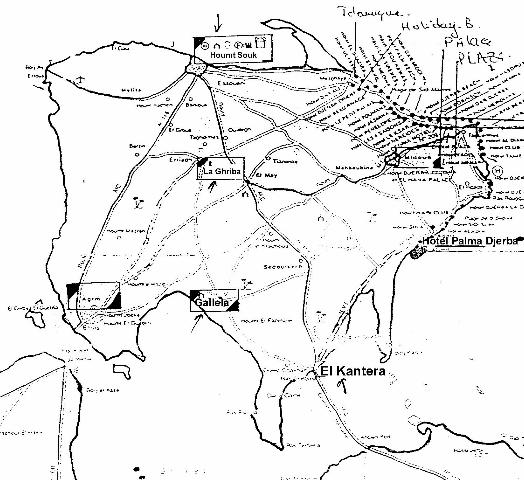
Intro
We - that is my friend Dirk and I - had decided we could not tolerate the awful German weather any longer and had to fly away to the sun. At first we had intended to fly to a Greek island, like Mykonos or Kos. However, there wasn't any room left for us in Greece, so we spontaneously switched to Tunisia - a good move as it turned out.
Now, our flight left from Frankfurt airport at 5:45 in the morning which was a bit of a drag but that's what you get from booking Last-Minute. The world-cup final was on the 12th of July and of course, there was no way we were going to miss that! We ended up watching it at the main train station in Frankfurt on a big screen with couple of hundred other travellers. To cut a long story short - there aren't any proper night-trains going from were we live to Frankfurt. After the football match - which as you probably know France won comfortably and well deserved it, too - we went on to Frankfurt airport. As opposed to some other airports in Germany (like Düsseldorf) Frankfurt airport is open 24h a day. Düsseldorf closes down completely at night. We had planned to visit the discotheque "Dorian Gray" which is located right inside the airport building but as luck would have it, it's closed on Sundays. So we spent the night opposite the discotheque in a small airport pub. By the time we were in the plane we could no longer be described as fit...
This was my first trip to Africa and as we approached the Tunisian coast all my expectations were fulfilled. The view from the plane's window was just as I had anticipated - a lot of sand with palm-trees and olive-groves, a sand-desert and a sparse sprinkling of houses. About 2 1/2 hours after leaving Frankfurt our plane was swooping down towards the island of Djerba and after a fairly good landing we and a couple of hundred other tourists disembarked from the Airbus. I, for one, was very glad to be out of it - not because I don't like flying (quite the opposite) but because I probably had the most annoying kids in the world sitting behind me. I hope those brats were bitten by a dromedary!
Arrival
As soon as we stepped out into the open, we were greeted by a heat wave. It was particularly intense for us, because we had had nothing but rain in Germany that summer. A short bus-ride from the plane's parking-lot to the airport-building later, we went through immigration. This took quite some time - as did the collection of our luggage but going out of the airport we were met by our agency's representative. This guy - a local - always seemed to be in a bit of a rush (which is unusual for Tunisians) but he took care of our transfer and soon we were sitting in a bus heading for our hotel.
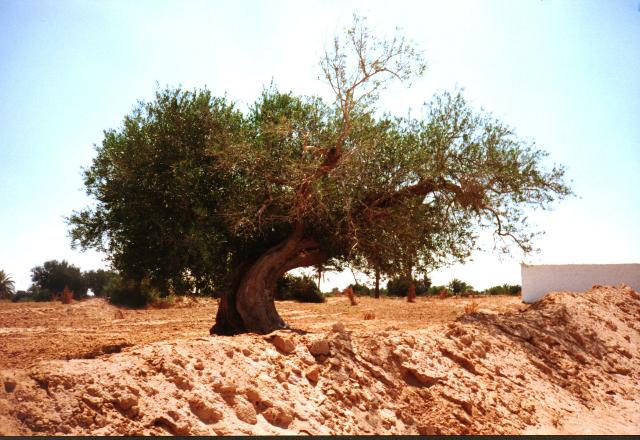 The Djerbian roads are not very busy (at least outside the cities), in mediocre repair and of a not very high standard. Our transfer took about 45 minutes and we got to see a bit of the island since we had to traverse it to reach our hotel. The airport is on the western side of Djerba, whereas our hotel is located on the eastern side. The first impression one has when driving through Djerba is that it's a very dry place - which was later confirmed by a travel-guide. It only rains about 30 days a years between November and January. Where there's water on the island you will find houses or villages. Ground-water is fairly hard to come by on the island which is why there is a water-pipeline to the island from mainland Tunisia. To the left and the right of the road there are some palms and olive trees, cacti and small shrubbery. Many people drive around on mopeds and motorcycles on Djerba and as in many southern countries the style of driving is well - poor.
The Djerbian roads are not very busy (at least outside the cities), in mediocre repair and of a not very high standard. Our transfer took about 45 minutes and we got to see a bit of the island since we had to traverse it to reach our hotel. The airport is on the western side of Djerba, whereas our hotel is located on the eastern side. The first impression one has when driving through Djerba is that it's a very dry place - which was later confirmed by a travel-guide. It only rains about 30 days a years between November and January. Where there's water on the island you will find houses or villages. Ground-water is fairly hard to come by on the island which is why there is a water-pipeline to the island from mainland Tunisia. To the left and the right of the road there are some palms and olive trees, cacti and small shrubbery. Many people drive around on mopeds and motorcycles on Djerba and as in many southern countries the style of driving is well - poor.
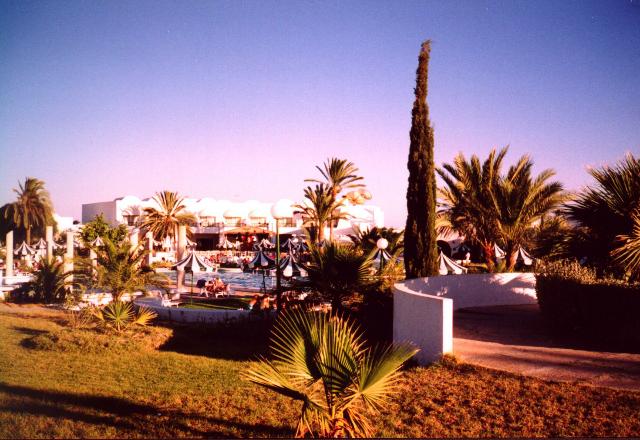 The hotel
The hotel
We arrived at the hotel - the Club Palma Djerba - with mixed expectations but were greeted in a very friendly way with a complimentary cocktail. After the formalities were taken care of, we were taken to our room - which can be described as spartan. We weren't going to let this spoil our holidays though and since we were only going to spend the nights in them we didn't really care. The main problem we had was the air-conditioning didn't really want to work and it took about three or four days to get it fixed, but after that it was really pleasant.
First of all we tested the beds - we had to catch up on a couple of hours of sleep and we emerged from our room in the late afternoon. We decided to take a look around the hotel-grounds and found numerous sporting activities on offer. The beach is directly adjacent to the hotel and there's a discotheque on the beach which is half-open towards the sea.
The food & hotel life
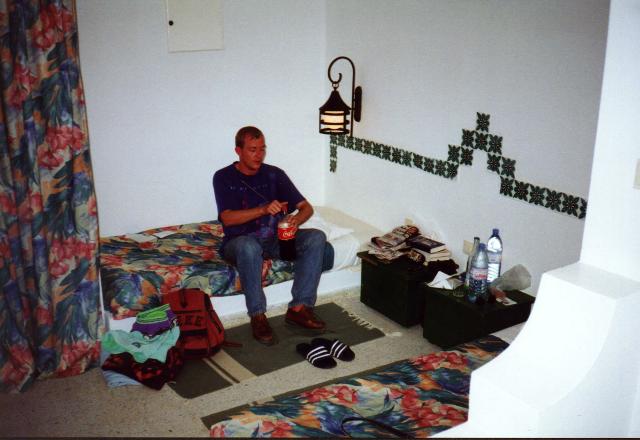 Breakfast and supper in the hotel consist of a buffet which offers a fairly good choice of international and local cuisine. The main clientele of this hotel is French which accounts for the free table-wine which is served. However, it doesn't account for the very poor quality of said wine. All in all one can say that the food in the hotel was OK but nothing to write home about. After supper there was always a show which was put on by the animateurs. The first evening there were get-to-know-each-other games and such. There was a pass-the-hat dancing competition where the couple wearing the hat when the music stopped was eliminated. I won second prize with a Belgian girl called Audrey. A big burly Russian guy - who was to appear again and again during the course of our holidays - took first prize. After the show there was always the "village-dance" - one of the these group-dances which is supposed to strengthen the communal spirit and form some kind of relationship between the guests and the hotel. I boycotted it but Dirk was happy enough to take part - I am not a fan of mass-organised entertainment.
Breakfast and supper in the hotel consist of a buffet which offers a fairly good choice of international and local cuisine. The main clientele of this hotel is French which accounts for the free table-wine which is served. However, it doesn't account for the very poor quality of said wine. All in all one can say that the food in the hotel was OK but nothing to write home about. After supper there was always a show which was put on by the animateurs. The first evening there were get-to-know-each-other games and such. There was a pass-the-hat dancing competition where the couple wearing the hat when the music stopped was eliminated. I won second prize with a Belgian girl called Audrey. A big burly Russian guy - who was to appear again and again during the course of our holidays - took first prize. After the show there was always the "village-dance" - one of the these group-dances which is supposed to strengthen the communal spirit and form some kind of relationship between the guests and the hotel. I boycotted it but Dirk was happy enough to take part - I am not a fan of mass-organised entertainment.
The next day and most of the following days were spent at the beach. The were sun-shades made of palm-leaves which offered a little protection from the sweltering sun. Unfortunately, the sea was not all that clean and there were a lot of algae floating about. The water in the hotel-pool was a bit murky as well but is still offered a refreshing swim.
July 14th
On the 14th of July - the French national holiday - there was a big banquet around the pool and there was a big show staged by the animateurs with lots of fire and horses and dromedaries - a big spectacle.
The people
The best thing about this holiday was that we met quite a lot of very nice people. The first of whom was Anke. Anke came from the vicinity of Stuttgart and spoke a very cute German dialect called Schwäbisch. She was 21 years old at the time and spent a week on Djerba with her mother. 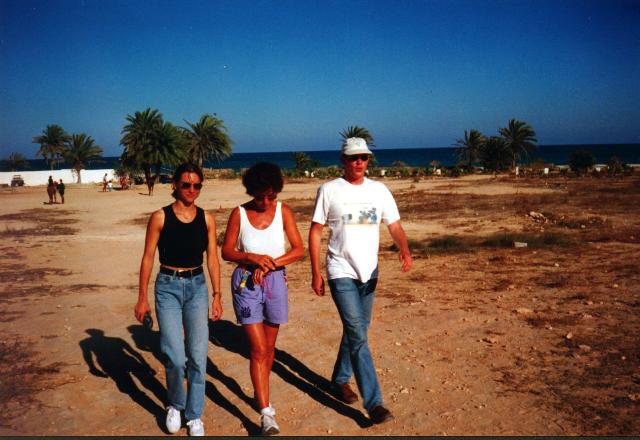 We were lucky to sit next to her on the third or fourth evening watching a show put on by the animateurs. She was very charming and we spent a nice couple of days and evenings with her. We went riding together and danced the nights away in the discotheque.
We were lucky to sit next to her on the third or fourth evening watching a show put on by the animateurs. She was very charming and we spent a nice couple of days and evenings with her. We went riding together and danced the nights away in the discotheque.
In general the people in and around the hotel were very nice. Of course, there were exceptions - for example some of the locals who operated a small supermarket near the hotel were a bit pushy for my liking especially towards the female tourists. They seemed to make it a sport to see how many girls they could grab in the discotheque.
The guys operating a small horse-ranch next to the hotel were very nice and we were invited to spend an evening with them which we gladly accepted.
The horse-riders
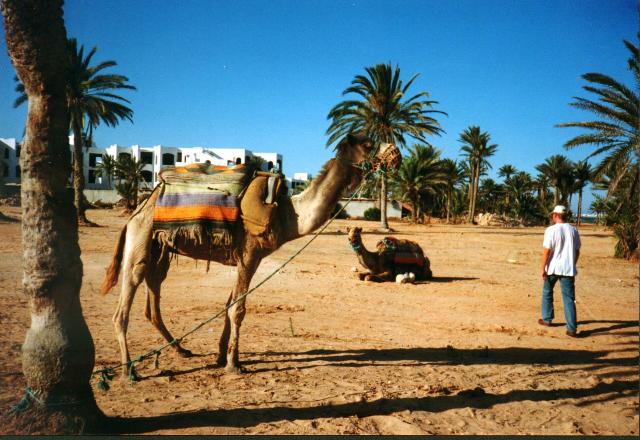 One evening Anke, Dirk and I went down to ranch after supper and sat and talked with the riders. We ate water-melon and found out about the island and their ranch and so on. They were very happy to talk to us. It helped them with their German - which they spoke surprisingly well - and also I think they hadn't expected us to show up. I imagine they invite quite a lot of people but not all that many actually come.
One evening Anke, Dirk and I went down to ranch after supper and sat and talked with the riders. We ate water-melon and found out about the island and their ranch and so on. They were very happy to talk to us. It helped them with their German - which they spoke surprisingly well - and also I think they hadn't expected us to show up. I imagine they invite quite a lot of people but not all that many actually come.
We had already ridden their horses, so they weren't trying to sell us anything anymore - which was nice. We had also ridden on a dromedary which was an experience in itself. It rocks a bit like a boat but it's quite a pleasant ride. It was a lot better than riding on the horses - at least for me because I had a very stubborn horse which wasn't all too enthusiastic about carrying me about in the blazing sunshine.
Markets
The next people we met were Anthony & Caroline from Paris also both very nice. Anthony used to be a tour guide in Tunisia in the 60s. I went to the island's capital Houmt Souk at the beginning of the second week. I had been taken ill with the runs for a couple of days during the first week and Dirk had them the second week. Anke had just left for Germany again.
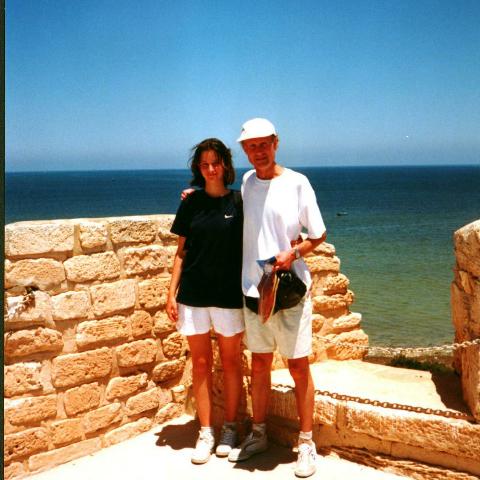 We took the bus into town which was about 25 kilometres away and joined the bustle of the markets. When trying to walk through a market in Tunisia it is impossible not to be hassled as a tourist. Every single merchant tries to stop you and show you his wares. The main problem is that they all try to sell the same stuff. You can either ignore them or tell them firmly that you don't want anything. If they manage to lure you into their shop you will almost certainly leave it again carrying something you didn't actually want to buy. If you do want to buy something, however, you absolutely HAVE to haggle. There aren't any price tags on the wares and if you ask the merchant how much an article costs, he dreams up a price and then doubles it. Therefore, good bargaining skills will get you some fairly cheap souvenirs. Life isn't expensive in Tunisia. Day-to-day goods can be purchased at very reasonable prices. The only things that are more expensive are those that tourists tend to take home with them.
We took the bus into town which was about 25 kilometres away and joined the bustle of the markets. When trying to walk through a market in Tunisia it is impossible not to be hassled as a tourist. Every single merchant tries to stop you and show you his wares. The main problem is that they all try to sell the same stuff. You can either ignore them or tell them firmly that you don't want anything. If they manage to lure you into their shop you will almost certainly leave it again carrying something you didn't actually want to buy. If you do want to buy something, however, you absolutely HAVE to haggle. There aren't any price tags on the wares and if you ask the merchant how much an article costs, he dreams up a price and then doubles it. Therefore, good bargaining skills will get you some fairly cheap souvenirs. Life isn't expensive in Tunisia. Day-to-day goods can be purchased at very reasonable prices. The only things that are more expensive are those that tourists tend to take home with them.
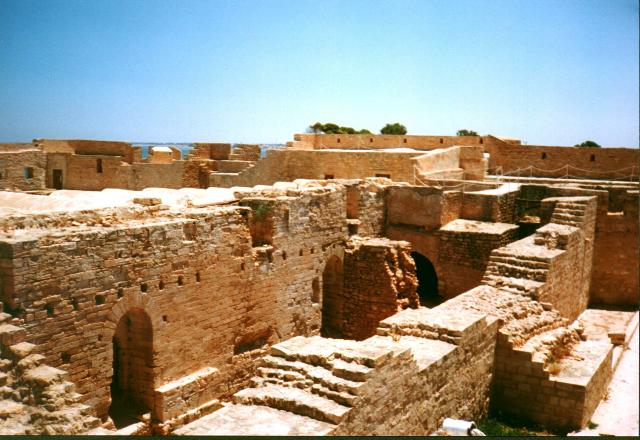 After perusing the market stalls we walked up to an old fort which had been built by the Spaniards during their occupation of the island. It has been restored on the outside but inside it's a ruin - great fun to go exploring in it though. You can go everywhere and climb around in the rubble. We also went into a hotel where Anthony had stayed 30 years previously - it brought back a lot of memories for him.
After perusing the market stalls we walked up to an old fort which had been built by the Spaniards during their occupation of the island. It has been restored on the outside but inside it's a ruin - great fun to go exploring in it though. You can go everywhere and climb around in the rubble. We also went into a hotel where Anthony had stayed 30 years previously - it brought back a lot of memories for him.
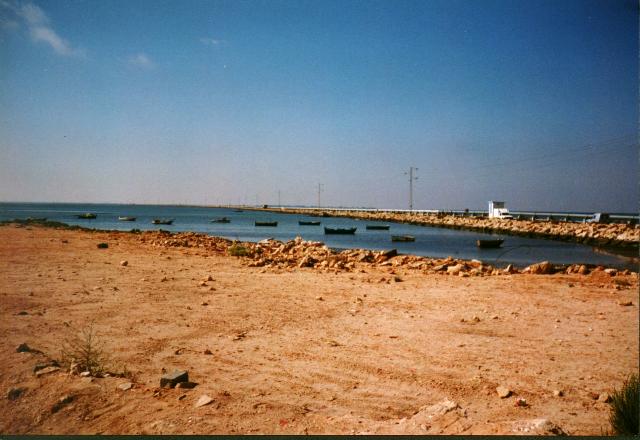 A trip round the island
A trip round the island
There were a number of trips on offer from our agency and we made our second week on the island our excursion-week. On Monday I had been to Houmt Souk and on Tuesday Dirk and I went on a coach-trip round the island. First we visited El Kantera which is an old Roman dam - the only land-connection between Djerba and mainland Tunisia. The dam can be used all throughout the year. There is a road leading across it alongside of which runs the aforementioned freshwater-pipeline. The dam is approximately seven kilometres long.
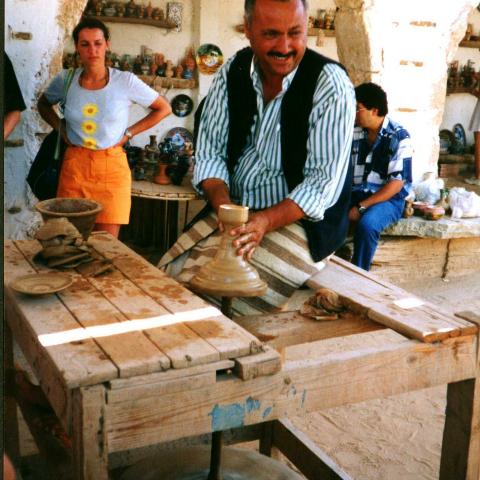 Afterwards we headed towards Gallela which is a town devoted entirely to pottery. There was a little pottery-demonstration there and a short break to do some shopping.
Afterwards we headed towards Gallela which is a town devoted entirely to pottery. There was a little pottery-demonstration there and a short break to do some shopping.
From there we continued on towards La Ghriba - a synagogue. I was quite surprised that we could actually enter the synagogue and even take pictures inside it. Djerba, like the whole of Tunisia is very liberal when it comes to religion. 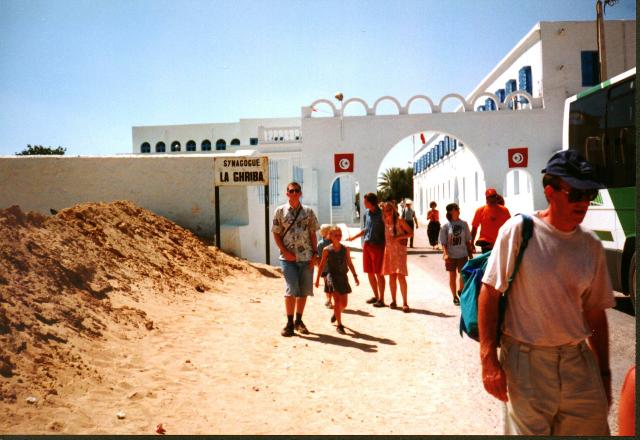 Most Tunisians are Muslims but as our guide pointed out there aren't any fundamentalists in Tunisia. He emphasised that the Muslims in Tunisia wanted no part in the violence perpetrated in the name of Allah. Apart from the Muslims there are a number of Christians on the island as well as a big Jewish community.
Most Tunisians are Muslims but as our guide pointed out there aren't any fundamentalists in Tunisia. He emphasised that the Muslims in Tunisia wanted no part in the violence perpetrated in the name of Allah. Apart from the Muslims there are a number of Christians on the island as well as a big Jewish community.
From there we went to Houmt Souk where we went to see a carpet factory. We saw the women weaving away and we could sit next to them for a bit. One of them told me that it took her about three months to finish one these carpets. However, their wages are extremely low. These women get around 3 Dinars A DAY which works out at roughly US$ 3 or DM 5.
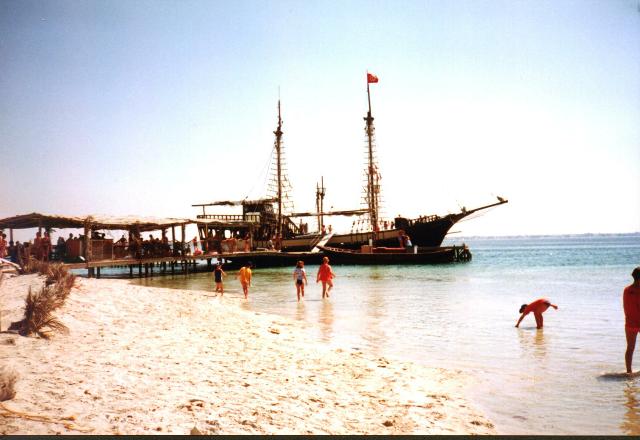 Flamingo Island
Flamingo Island
On Wednesday we went sailing. We had booked a trip on a boat which started in the harbour of Houmt Souk and took us out to Flamingo Island - so called because it's the winter residence of hundreds if not thousands of pink flamingos. However, when we went there all the flamingos were somewhere else in the world. The water around Djerba is very shallow. In fact, they had to dig a canal 8 kilometres long and 75 metres wide to get to deeper waters. It is possible to walk from Djerba to the mainland during low-tide. On the way out we stopped and had the chance to swim in the Mediterranean for a while. The water was nice and warm and incredibly salty. It's fun to jump off a boat - especially when it's not burning or sinking...
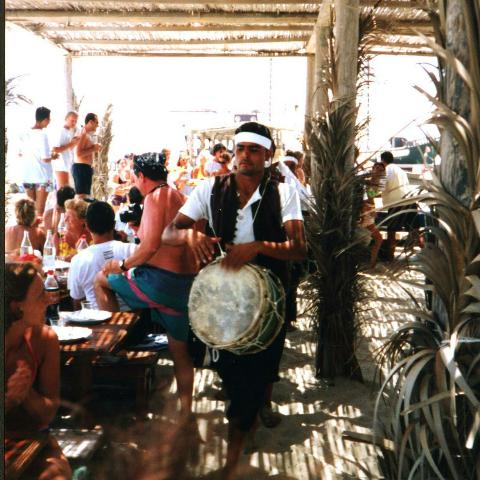 On arrival at Flamingo Island we went oyster-hunting. Right off the island's shore lie big banks of oysters just waiting to be picked up by tourists (how convenient). We were given a nice meal and there was music and a show. We went on this trip together with a nice couple - Kerstin and Matthias - from Frankenthal which lies in the German Palatinate and a family from the Sauerland. The father is a professor in Paderborn - also very nice people.
On arrival at Flamingo Island we went oyster-hunting. Right off the island's shore lie big banks of oysters just waiting to be picked up by tourists (how convenient). We were given a nice meal and there was music and a show. We went on this trip together with a nice couple - Kerstin and Matthias - from Frankenthal which lies in the German Palatinate and a family from the Sauerland. The father is a professor in Paderborn - also very nice people.
Sadly, we didn't any dolphins on this trip. The sailor had got our hopes up by telling us that during the last couple of days he had seen quite a number of them swimming about in these waters.
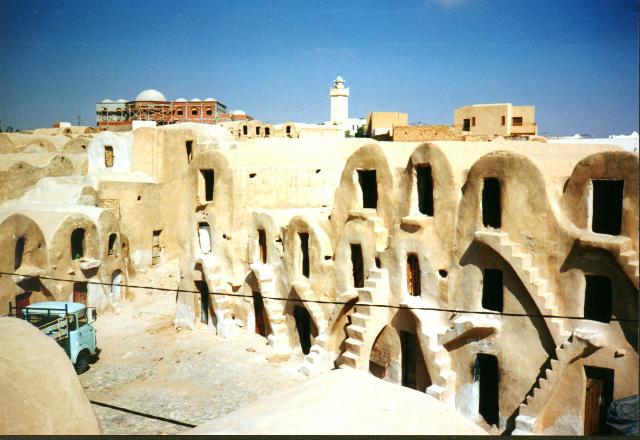 Gabes ~ Matmata
Gabes ~ Matmata
On Saturday we went on our final excursion - a big tour starting early in the morning. We were picked up by a Land-Rover, went by a couple of other hotels and set off with a number of other jeeps towards El Kantera and mainland Tunisia. There were seven of us plus the driver in our jeep - we had the only one with air conditioning. We made a brief stop at the dam which is supervised by a national guard barracks. There are police checks before you drive onto the dam. In general, there are a lot of police about and our guide explained this was due to the closeness to Libya.
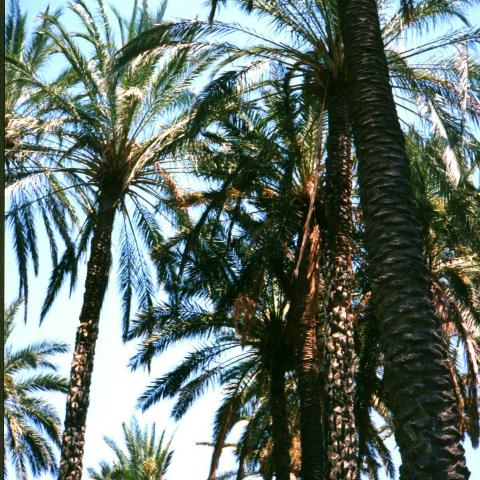 We crossed El Kantera and headed past the olive groves of Zarzis towards the oasis of Gabes. This is a very big oasis, which lies very close to the coast. It is the home to about 300,000 date-palms. The oasis is privately owned and each farmer is allotted as much water as he needs for his palm-trees. This visit totally destroyed the picture I carried around in my mind about oases. I had always believed an oasis to have a kind of a small lake or waterhole in the middle and palm trees standing in a circle around it. But Gabes is very big. It has a village inside it where people have built houses and roads and workshops. We went through the oasis in a horse-drawn carriage.
We crossed El Kantera and headed past the olive groves of Zarzis towards the oasis of Gabes. This is a very big oasis, which lies very close to the coast. It is the home to about 300,000 date-palms. The oasis is privately owned and each farmer is allotted as much water as he needs for his palm-trees. This visit totally destroyed the picture I carried around in my mind about oases. I had always believed an oasis to have a kind of a small lake or waterhole in the middle and palm trees standing in a circle around it. But Gabes is very big. It has a village inside it where people have built houses and roads and workshops. We went through the oasis in a horse-drawn carriage. 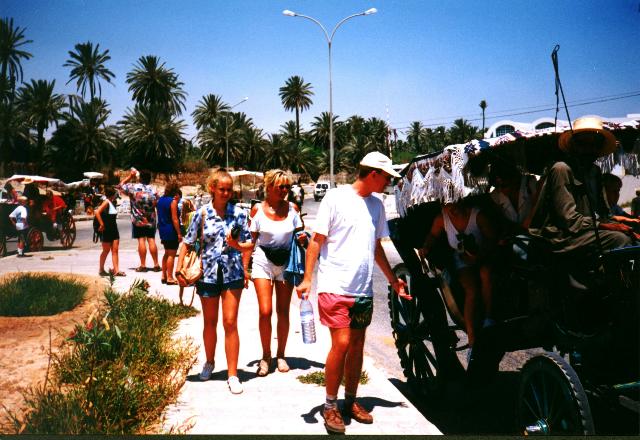 This is where we met Sina and her mother Annette. Sina's a charming and pretty girl from a city quite near us. It's a shame I met her so late during my stay. We all stopped somewhere in the oasis and got out to take a walk, where we were offered some palm-juice and sheep's fleeces. I actually ended up buying a fleece but only after some very arduous bargaining. In fact, we had already departed in our carriage again without a sale and then this guy followed us on his moped and we carried out the transaction en route.
This is where we met Sina and her mother Annette. Sina's a charming and pretty girl from a city quite near us. It's a shame I met her so late during my stay. We all stopped somewhere in the oasis and got out to take a walk, where we were offered some palm-juice and sheep's fleeces. I actually ended up buying a fleece but only after some very arduous bargaining. In fact, we had already departed in our carriage again without a sale and then this guy followed us on his moped and we carried out the transaction en route.
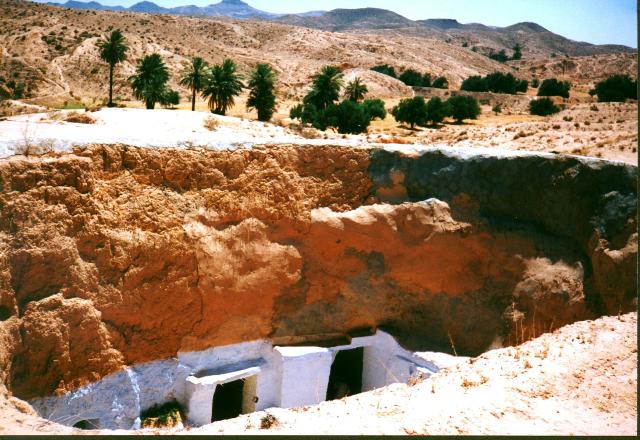 After that we went to see the Bedouin cave settlements between Gabes and Matmata. These people actually still live in caves carved into the hills. We were taken to the settlement by dromedary and after we had had a look around we rode back again. After that we went into Matmata for dinner. On our way back towards Djerba we stopped where the beginning of Star Wars was filmed. A couple of shortcuts later we arrived at the ferry which was going to take us back to Djerba. During the wait I went forward to the other jeep and talked with Sina while Dirk stayed behind. When the line moved forward, I rode along on the outside of the jeep - which was great fun.
After that we went to see the Bedouin cave settlements between Gabes and Matmata. These people actually still live in caves carved into the hills. We were taken to the settlement by dromedary and after we had had a look around we rode back again. After that we went into Matmata for dinner. On our way back towards Djerba we stopped where the beginning of Star Wars was filmed. A couple of shortcuts later we arrived at the ferry which was going to take us back to Djerba. During the wait I went forward to the other jeep and talked with Sina while Dirk stayed behind. When the line moved forward, I rode along on the outside of the jeep - which was great fun.
July 25th
The 25th of July is a Tunisian national holiday - it's also the same day we did the Gabes - Matmata trip. In the evening there was a big banquet by the pool and the animateurs put on a big show around and in the pool. However, it was the same one they had put on for the 14th of July celebrations.
Sailing
On Sunday - our last day - I spontaneously went sailing with Sina, a girl called Christine from Hamburg and a group of Tunisians. I actually managed to pick up a bit of a sunburn on my last day by being on the water for about half an hour. It was good fun though and I even saw a (sting?-)ray in the water. Since I wasn't prepared for going into the water that day (I only wanted to pack dry clothes) I was wearing shorts which promptly got wet when we all had to help push the boat back onto the beach. But everything dried nice and fast under the Tunisian sun...
Back to the rain
On Monday, the 27th of July we headed back to Germany again - sad to leave a nice island and nice people behind, yet glad in a way to be heading home to comfort. I would say it was well worthwhile and it's a place I can recommend visiting - but, I think, once is enough for me. Maybe in years to come I'll return to Tunisia but right now I've had enough...
For further reading
Featured on
![[ReiseTräume WeltWeit] - Planen Sie jetzt Ihren Traumurlaub mit Informationen aus erster Hand (Berichte, Fremdenverkehrsämter, Linksammlungen, Photogalerien, ...)](http://www.reisetraeume.de/media/logk_weltweit.gif)
ReiseTräume WeltWeit




![]()

















